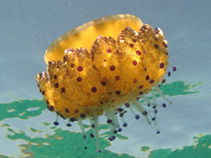Cotylorhiza tuberculata (Macri, 1778)
Warning: DOMDocument::load(): SSL operation failed with code 1. OpenSSL Error messages: error:140770FC:SSL routines:SSL23_GET_SERVER_HELLO:unknown protocol in C:\Apache24\htdocs\includes\SpeciesSummary.lib.php on line 1236
Warning: DOMDocument::load(): Failed to enable crypto in C:\Apache24\htdocs\includes\SpeciesSummary.lib.php on line 1236
Warning: DOMDocument::load(https://sealifebase.nrm.se/webservice/AquaMaps/getAMap.php?genus=Cotylorhiza&species=tuberculata): failed to open stream: operation failed in C:\Apache24\htdocs\includes\SpeciesSummary.lib.php on line 1236
Warning: DOMDocument::load(): I/O warning : failed to load external entity "https://sealifebase.nrm.se/webservice/AquaMaps/getAMap.php?genus=Cotylorhiza&species=tuberculata" in C:\Apache24\htdocs\includes\SpeciesSummary.lib.php on line 1236
Classification / Names Common names | Synonyms | CoL | ITIS | WoRMS
| Rhizostomeae | Cepheidae
Environment: milieu / climate zone / depth range / distribution range Ecologia
Pelágico(a,os,as); intervalo de profundidade 0 - 7 m (Ref. 3254). Subtropical
Distribuição Países | Áreas FAO | Ecossistemas | Ocorrências | Introduções
Mediterranean Sea: Italy, Greece and Monaco.
Length at first maturity / Tamanho / Peso / Idade
Maturity: Lm ? range ? - ? cm Max length : 40.0 cm WD macho/indeterminado; (Ref. 358)
Descrição suscinta Morfologia
Diameter can reach 40 cm. Plane sunshade, except in its center, where one observes a prominent formation out of bell. Short oral arms, only braided in their base, characterized by a lower part excessively friz; the labial palpi are of color violet or white, and finished by a widened bulb. The sunshade is white, the oral arms of a tinted white of yellow. The polyps measure from 5 to 10 mm height; and although unimportant, one can observe them all the year.
The sunshade of the céphéides is frequently used as protective shelter with fish alevins of the kinds Trachurus ,Boops and Seriola. Species is inoffensive for the man (Ref. 358). Swims to the surface in plain water, in pelagic zone, near the coasts at night. Feeds on fine plankton, which is absorbed by the oral arms (Ref. 358).
Life cycle and mating behavior Maturidade | Reprodução | Desova | Ovos | Fecundidade | Larvas
The polyps start to bud at the beginning of spring. These larvae evolve/move in jellyfishes, which one meets only from July to November, frequently associated gigantic swarms, length of several kilometers. When a storm prevails, the jellyfishes gagnet bottom. But one also observes this type of migration of surface towards deep water independently of any climatic factor. The males become ripe are recognizable with the presence, in some their palpi, spermatic channels filled up of gametes and colored in white, which will be released in the marine environment. Fecundation takes place inside the body of the females. Before their emission in the sea, the larvae remain a few times inside specialized oral arms, responsible for incubation. Then they will evolve/move in sedentary polyp (Ref. 358).
Referência principal
Referências | Coordenador | Colaboradores
Göthel, H. 1992. (Ref. 358)
Status na Lista Vermelha da IUCN (Ref. 130435)
Status no CITES (Ref. 108899)
Not Evaluated
CMS (Ref. 116361)
Not Evaluated
Perigo para os humanos
Uso pelos humanos
| FishSource |
Ferramentas
Mais informação
Fontes da internet
BHL | BOLD Systems | CISTI | DiscoverLife | FAO(Publication : search) | Fishipedia | GenBank (genoma, nucleotídeo) | GloBI | Gomexsi | Google Books | Google Scholar | Google | PubMed | Árvore da vida | Wikipedia (Ir para, procura) | Registro zoológico
Estimates based on models
Preferred temperature
(Ref. 115969): 17.7 - 19.3, mean 18.6 (based on 190 cells).
Resiliência
(Ref. 69278):
Elevada, tempo mínimo de duplicação da população menor que 15 meses (K=0.73-2.1).
Categoria de preço
(Ref. 80766):
Unknown.



